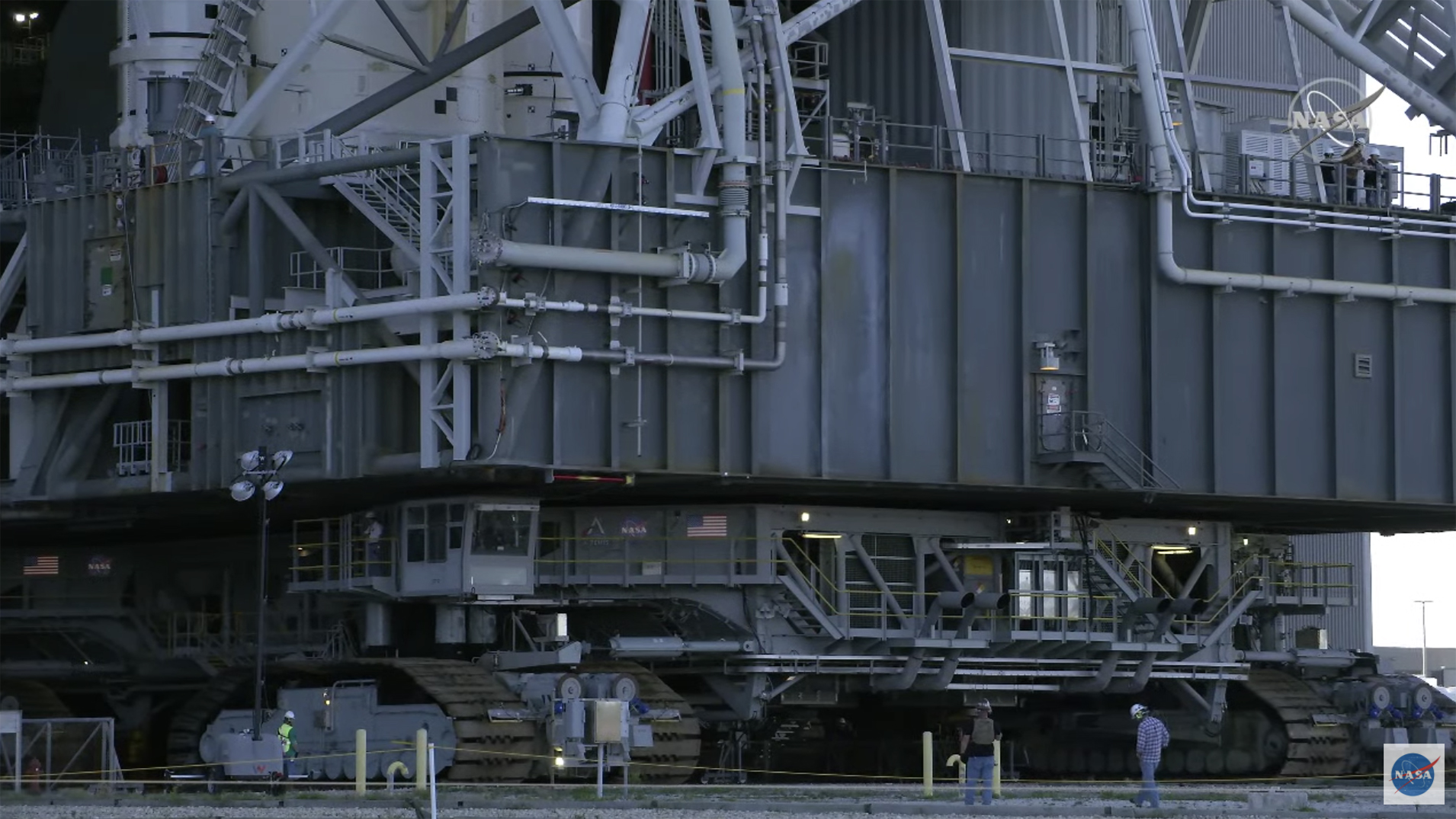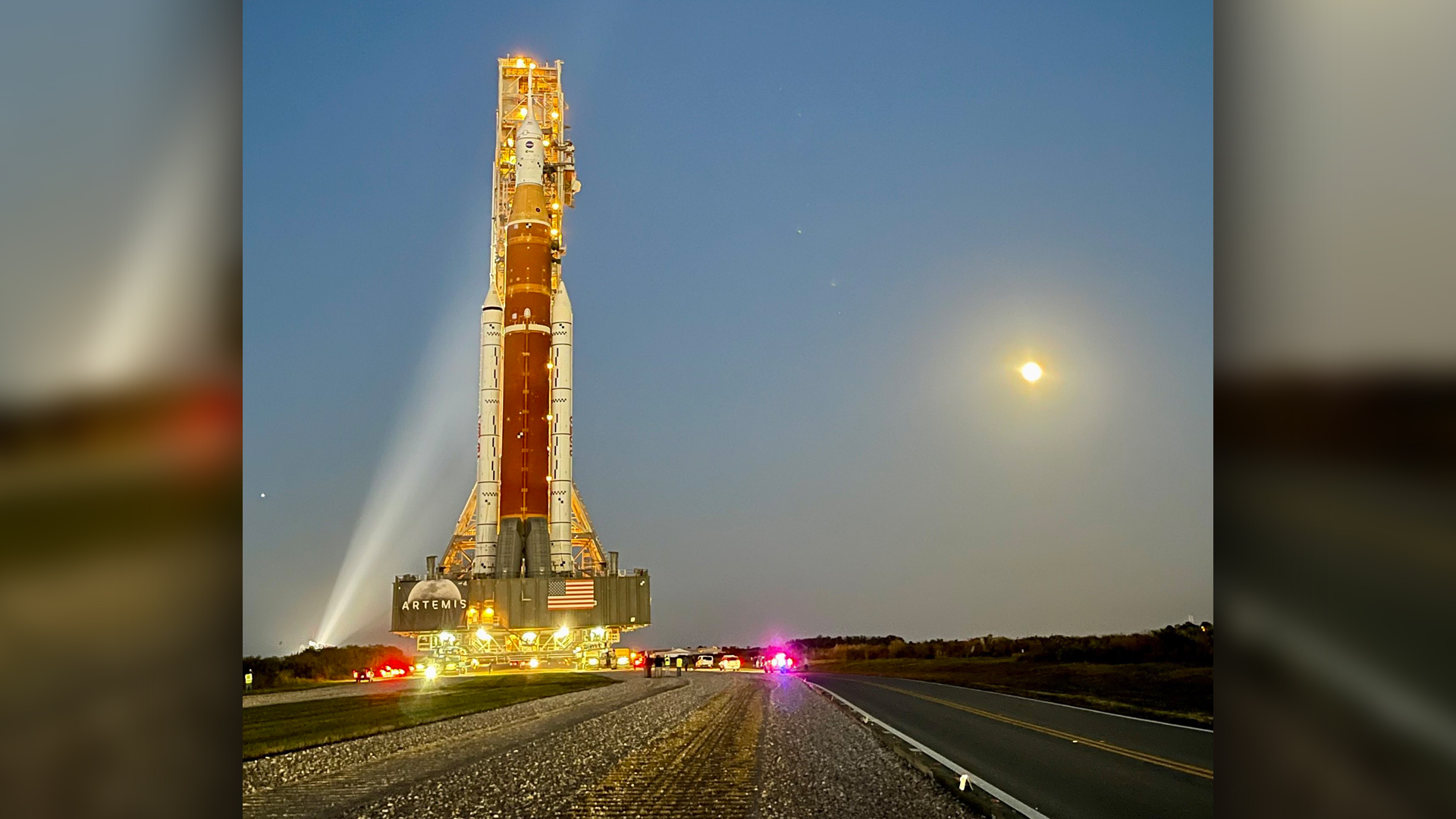NASA's Artemis moon rocket just rode a 'supertank' to the launch pad
The mission's "wet dress rehearsal" will take place on April 1.

Inch by inch, NASA's Artemis I spacecraft and rocket have finally chugged all the way to the launch pad, reaching their destination in the predawn hours of Friday (March 18). They arrived at 4:15 a.m. EDT, 10 hours and 28 minutes after the rollout began on Thursday (March 17) at 5:47 p.m. EDT.
While 11 hours might sound like a long time for a 4-mile (6.4-kilometer) trip, the lunar rocket's arrival at Launch Pad 39B at the Kennedy Space Center in Cape Canaveral, Florida was right on schedule. It departed from Kennedy's Vehicle Assembly Building and traveled at a cruising speed of just under 1 mph (1.6 km/h) for much of the journey, carried by NASA's enormous Crawler-Transporter 2 (CT-2).
"Rolling out of the Vehicle Assembly Building is an iconic moment for this rocket and spacecraft, and this is a key milestone for NASA," Tom Whitmeyer, deputy associate administrator for Common Exploration Systems Development at NASA Headquarters in Washington, said in a statement. "Now at the pad for the first time, we will use the integrated systems to practice the launch countdown and load the rocket with the propellants it needs to send Orion on a lunar journey in preparation for launch."
On Friday (March 18) at 5:29 a.m. EDT, NASA's Kennedy Space Center tweeted that the Orion spacecraft and the Space Launch System (SLS) rocket "have arrived at Launch Complex 39B! The team will now begin final preparations ahead of the wet dress rehearsal test."
🚀 @NASA_SLS and @NASA_Orion have arrived at Launch Complex 39B! The team will now begin final preparations ahead of the wet dress rehearsal test.📸: @nasahqphoto pic.twitter.com/Rym8s63jMgMarch 18, 2022
Though Orion and SLS are now parked at the launch pad, they won't be taking off for the moon just yet. Liftoff is still at least a month away, as there are a number of tests that mission engineers and technicians must perform before pronouncing the rocket ready to take flight.
Artemis will fly to the moon — and beyond — in three stages. Artemis I, now at Launch Pad 39B, is an uncrewed roundtrip mission that will travel 280,000 miles (450,000 kilometers) into space, going farther than any spacecraft built to carry humans has ever gone before, according to NASA. Artemis II, expected to launch in 2024, will also conduct a flyby of the moon, but this time the Orion spacecraft will have human passengers. The final stage, Artemis III, will return humans to the lunar surface, bringing the first woman and the first person of color to the moon.
Related: NASA prepares 'moonikin' for spaceflight aboard 1st Artemis mission
Get the world’s most fascinating discoveries delivered straight to your inbox.
Transporting the integrated Orion and SLS is the tremendous crawler CT-2, which measures 131 feet (40 meters) long and 114 feet (35 m) wide, and weighed about 21.5 million pounds (9.8 million kg) while bearing its heavy Artemis payload. Steering this metal behemoth "is kind of like driving a supertank," said John Giles, an engineering operations manager for Kennedy's crawler-transporters.
"It doesn't stop fast, it doesn't move fast, you have to think way ahead when you're going to make turns," Giles said during a stream of the rollout on NASA's YouTube channel. In addition to the drivers, many other people were actively involved to make sure that the crawler moved safely from building to launch pad, including engineers, technicians, mechanics, logistics personnel, and even observers to help the drivers see where they're going.
"Everybody's on headsets and they're all talking to each other. It's a huge undertaking," Giles said.
"Wet Dress Rehearsal"
Next up for Artemis I is the so-called wet dress rehearsal, to take place on April 1, when technicians will load up the rocket with over 700,000 gallons (2 million liters) of liquid oxygen and hydrogen propellant and perform countdown tests, Cliff Lanham, a senior vehicle operations manager for Kennedy's Exploration Ground Systems (EGS) Program, said during the NASA stream.
For the countdowns, the team will run through the actual procedures that lead up to a launch, Lanham said. They'll count to below a minute, recycle back up to 10 minutes, and then count back down to less than 10 seconds. Once testing is over, they'll drain the fuel from the rocket, evaluate the data "and see how we did," Lanham said.
"It will take one to two weeks before they'll be ready to say the test is fully successful and we're ready to start thinking about setting a launch date," he said.
While Artemis I won't carry human passengers, its seats won't be empty. Two female-bodied model human torsos — "Zohar" and "Helga," named respectively by the Israel Space Agency and the German Aerospace Center — will help scientists measure radiation levels during moon missions, and a life-size male manikin named "Commander Moonikin Campos" will be placed in the commander's seat. The "Commander" will wear the same spacesuit that Artemis astronauts will wear during launch, re-entry and other parts of their missions, but with extra sensors for collecting data about radiation, acceleration and vibration during the Artemis I flight, NASA representatives said in a statement.
One more passenger will be onboard: an orange-jumpsuit-wearing stuffed Snoopy doll. As the mission' official zero gravity indicator, Snoopy will provide NASA with a visual indicator when the spacecraft's interior has reached the weightlessness of microgravity, NASA says.
EDITOR'S NOTE: This article was updated at 9:37 a.m. on March 18 to include Artemis' official arrival time at the launch pad and remarks by NASA's Tom Whitmeyer, provided by NASA.
Originally published on Live Science.

Mindy Weisberger is a science journalist and author of "Rise of the Zombie Bugs: The Surprising Science of Parasitic Mind-Control" (Hopkins Press). She formerly edited for Scholastic and was a channel editor and senior writer for Live Science. She has reported on general science, covering climate change, paleontology, biology and space. Mindy studied film at Columbia University; prior to LS, she produced, wrote and directed media for the American Museum of Natural History in NYC. Her videos about dinosaurs, astrophysics, biodiversity and evolution appear in museums and science centers worldwide, earning awards such as the CINE Golden Eagle and the Communicator Award of Excellence. Her writing has also appeared in Scientific American, The Washington Post, How It Works Magazine and CNN.




